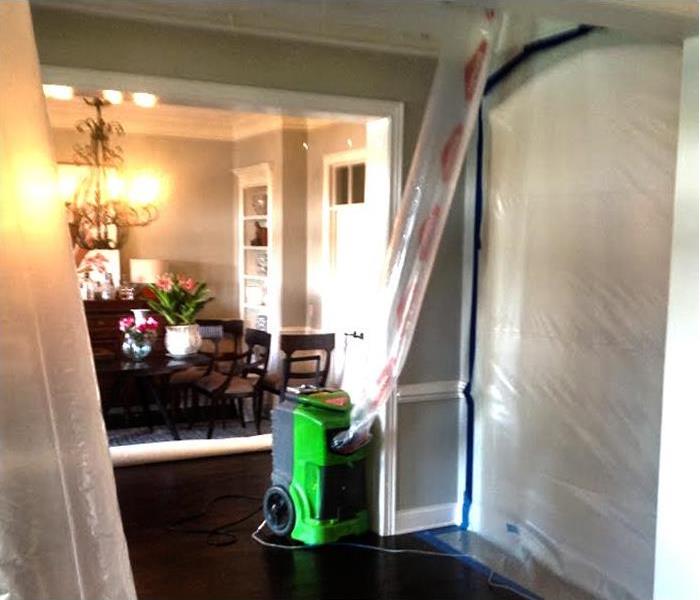5 Steps Used for Mold Remediation
3/12/2018 (Permalink)
 In this instance, water was still present in the affected area, so a dehumidifier forces hot air into the contained environment to continue drying.
In this instance, water was still present in the affected area, so a dehumidifier forces hot air into the contained environment to continue drying.
Mold in your Winter Park home or business can appear without warning and spread rapidly. While size and severity of a mold remediation job can vary, the 5 steps shared below are the foundation of the process we use every time.
Step 1: Mold Inspection
In Florida, the law states that the mold testing company cannot perform the actual remediation. We recommend having a mold assessment company take air quality samples in and outside of your property first. After receiving the test results from the samples and a protocol to perform an inspection, we then send a technician to thoroughly inspect and assess the damage to your property.
Our inspector checks for visible signs of the mold first and then proceeds to identify places where it may be hidden such as cabinets, baseboards, sheetrock, and under carpeting. Prior to remediation in areas over 10 square feet, it is important to have mold samples taken and tested.
Step 2: Mold Containment
The initial step is the most vital when beginning mold remediation. To ensure mold spores do not spread throughout your home, plastic barriers must be placed to separate affected and unaffected areas. We create a contained environment by systematically setting up a barrier and using negative air pressure. Negative air pressure creates a vacuum that forces the surrounding air that may contain mold spores into the contained environment. All entrances and exits of the area are completely sealed to prevent the spores from contaminating the rest of the property.
Step 3: Air Filtration
To achieve successful air filtration, we use powerful HEPA vacuums and air scrubbers. HEPA (High-Efficiency Particulate Air) vacuums work by forcing air through a fine mesh to trap harmful particles. Some of the particles captured by a HEPA filter include pollen, pet dander, dust mites, and tobacco smoke. Our technicians perform this step to capture mold spores that become airborne after removing drywall and similarly affected components of the property.
Step 4: Mold Removal
The mold removal step can vary in difficulty and length of time based on the extent of the damage and size of the affected area. Our technicians use antifungal and antimicrobial treatments such as Benefect, which is a plant-based and safe-to-use treatment. These treatments work to eliminate existing mold colonies and prevent new colonies from growing. In larger mold removal jobs, it is not uncommon for carpet and drywall to be removed as well, especially if they are infected with mold.
Step 5: Restoration
After removal, the next step is to clean and disinfect components of the property that have been affected by mold. Items such as curtains and furniture will be cleaned and deodorized. Repairs such as carpet replacement and painting are also made to restore the area. Because mold is a living organism that thrives inside of drywall, baseboards, cabinets, and clothing, it is necessary to remove them completely to eliminate the problem.
Your Local SERVPRO
SERVPRO of Winter Park is a family-owned business and knows what it takes to help you with your mold disaster. Give us a call to speak with a mold remediation expert and get the process started.





 24/7 Emergency Service
24/7 Emergency Service